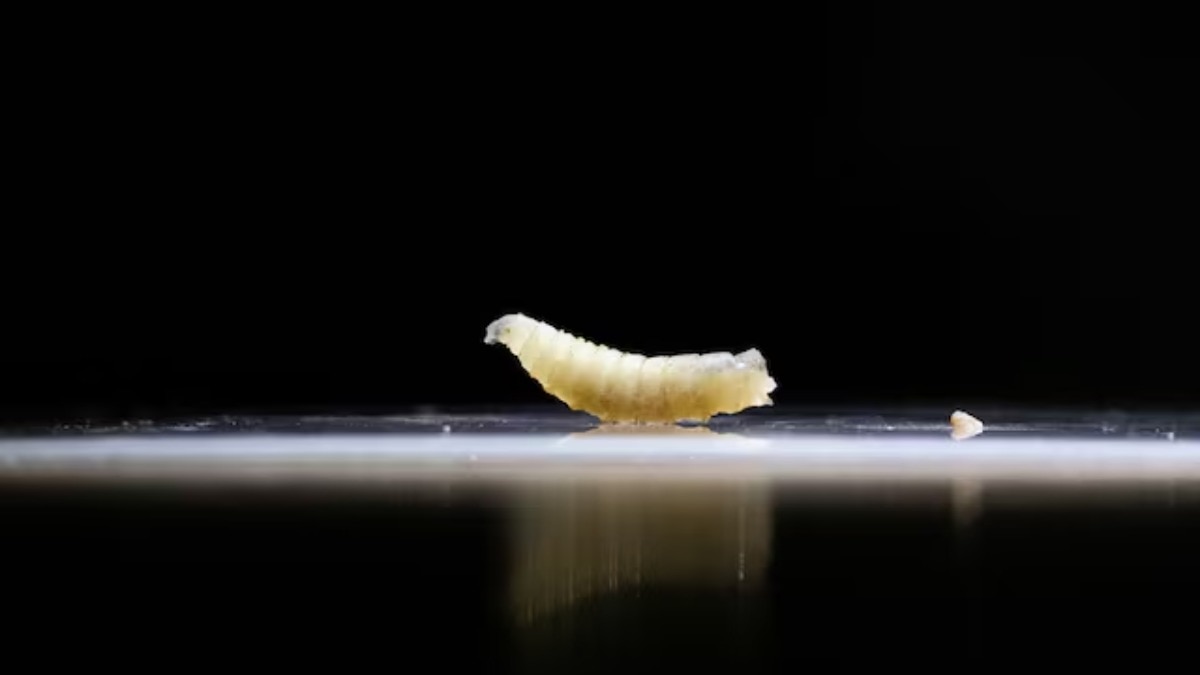Last Updated:August 25, 2025, 11:43 IST
Decades after the US declared it eradicated, a rare flesh-eating parasite has resurfaced in a person who returned from Central America, raising concerns among health officials

Larvae of the screwworm fly, collected from infected cows, are observed at the COPEG sterile fly production plant, which fights the spread of the cattle screwworm, in Pacora, Panama. REUTERS/File Photo)
For the first time, a case of the flesh-eating screwworm parasite has been confirmed in a person in the United States, triggering fresh concerns among health authorities and the cattle industry. The infection, reported in Maryland, has been traced to a traveller who returned from Central America, where a broader outbreak has been spreading north since late 2023.
The screwworm is not a worm but a species of fly whose larvae feed on the living flesh of animals, and in rare cases, humans, by burrowing into open wounds.
While officials stress that the public health risk remains low, the incident has reignited anxieties over the parasite’s economic impact, especially in cattle-rich states like Texas. So, what is the screwworm? Where did this infection originate? And why is it being called a billion-dollar threat?
What Happened In The US
According to the US Department of Health and Human Services (HHS), the case was detected in a patient from Maryland who had recently travelled to El Salvador, a country currently experiencing a screwworm outbreak. The Centers for Disease Control and Prevention (CDC) confirmed the infection on August 4 through telediagnosis, a remote method where specialists review images of the parasite, much like a virtual second opinion for lab specimens.
However, confusion over the patient’s travel history has deepened. While HHS spokesperson Andrew Nixon cited El Salvador, multiple Reuters sources from the beef industry said the traveller had returned from Guatemala. Nixon declined to clarify the discrepancy.
Despite the contradiction, health officials agree on one key point: “The risk to public health in the United States from this introduction is very low," Nixon told Reuters. No animal infections have been confirmed in the US so far this year.
In July, Mexico reported a new screwworm case in Ixhuatlán de Madero, Veracruz, just 370 miles south of the US border, raising further concerns that the parasite is moving steadily closer.
What Is A Screwworm?
The New World screwworm (Cochliomyia hominivorax), also known as NWS, is a parasitic fly endemic to Central and South America, the Caribbean, and parts of Mexico. Unlike common maggots that consume dead tissue, screwworm larvae feed exclusively on living flesh.
Female flies lay hundreds of eggs in the open wounds of warm-blooded animals, including humans. Once hatched, the larvae burrow deeper into tissue using sharp, screw-like mouths. This behaviour gives the parasite its name.
If left untreated, the infestation, known as myiasis, can become fatal. The damage caused by even a single female fly’s brood is immense: one fly can lay up to 3,000 eggs during its lifespan.
What Are The Symptoms And Risk Factors?
Screwworm infestations are rare in humans, but when they do occur, they are extremely painful and medically urgent. According to CDC advisories, symptoms can include:
Skin wounds that worsen over time and do not healA feeling of larvae moving inside a wound, nose, mouth, or eyeMaggots visible in open soresFoul-smelling odour from the infected areaSecondary bacterial infections, sometimes leading to high fever and chillsPeople are more vulnerable if they:
Have open wounds, even minor insect bitesSleep outdoors or live near livestockHave compromised immunity or existing skin conditionsTravel to endemic regions in Latin America and the CaribbeanThe only treatment involves physically removing the larvae and thoroughly disinfecting the wound. If caught early, infestations are typically survivable.
Why The Beef Industry Is On High Alert
While human cases are rare, screwworms are a major threat to livestock. An unchecked outbreak can decimate cattle populations by feeding on wounds caused by branding, birthing, or minor injuries. Texas A&M University estimates that a full-blown screwworm resurgence in Texas could cost $1.8 billion, including livestock deaths, treatment, and labour.
The stakes are high: the US imports over a million cattle from Mexico annually for beef processing. A growing screwworm presence in southern Mexico has already led to border closures, market disruptions, and price spikes.
Traders and ranchers have expressed concern over the CDC’s lack of transparency. Beth Thompson, South Dakota’s state veterinarian, told Reuters she learned about the Maryland case not through official channels, but via industry sources. “We found out via other routes and then had to go to CDC to tell us what was going on," she said. “They weren’t forthcoming at all."
Industry communications reviewed by Reuters also noted that the CDC was legally required to notify both Maryland health authorities and the state veterinarian once the case was confirmed.
Is This The First Time Screwworm Has Been Found In The US?
Not entirely. The US had previously eradicated screwworms by 1966, using a revolutionary strategy: the mass release of sterile male flies, which mate with wild females to produce infertile eggs. Since female screwworms only mate once, flooding the area with sterile males causes a rapid drop in the wild population over time.
This programme, managed by the US Department of Agriculture (USDA), successfully eliminated the parasite from US soil and even halted a small outbreak in the Florida Keys in 2017.
But the threat has returned due to a new outbreak that began in Central America and southern Mexico in 2023. Since then, screwworm cases have been reported steadily farther north, prompting the USDA to take emergency measures.
What Is The US Government Doing Now?
The screwworm detection comes just a week after USDA Secretary Brooke Rollins visited Texas to announce a new sterile fly facility near the Mexico border. The centre, to be built at Moore Air Force Base in Edinburg, will take two to three years to become operational.
Currently, only one such plant exists—in Panama—and it can produce 100 million sterile flies a week. But the USDA estimates that five times that number is needed weekly to push the parasite back to the Darien Gap, the dense rainforest between Panama and Colombia.
Meanwhile, Mexico has begun constructing its own $51 million sterile fly facility in the country’s south to contain the outbreak.
Why This Case Could Still Have A Big Impact
Even though the Maryland case is being treated as isolated and imported, it has already rattled the livestock sector. Beef prices were already high due to record-low cattle inventory. Now, even a perception of infestation can trigger panic in the futures market.
As one Beef Alliance executive reportedly wrote in internal emails (seen by Reuters), industry leaders feared a media leak could amplify volatility: “We remain hopeful that… the likelihood of a positive case being leaked is low, minimising market impact."
The Bottom Line
The detection of New World screwworm in a Maryland patient is not just a rare parasitic infection; it’s a warning shot for the US cattle industry and a test of its biosecurity systems. While the immediate health threat appears minimal, the economic and agricultural risks are significant, especially with fly populations inching closer to the US border.

Karishma Jain, Chief Sub Editor at News18.com, writes and edits opinion pieces on a variety of subjects, including Indian politics and policy, culture and the arts, technology and social change. Follow her @kar...Read More
Karishma Jain, Chief Sub Editor at News18.com, writes and edits opinion pieces on a variety of subjects, including Indian politics and policy, culture and the arts, technology and social change. Follow her @kar...
Read More
August 25, 2025, 11:41 IST
News explainers Wiped Out In 1960s, A ‘Flesh-Eating’ Fly Found Infecting Person In US: What Is Screwworm?
Disclaimer: Comments reflect users’ views, not News18’s. Please keep discussions respectful and constructive. Abusive, defamatory, or illegal comments will be removed. News18 may disable any comment at its discretion. By posting, you agree to our Terms of Use and Privacy Policy.
Read More

 5 hours ago
5 hours ago












